Intel Core i7-11700K Review: Blasting Off with Rocket Lake
by Dr. Ian Cutress on March 5, 2021 4:30 PM EST- Posted in
- CPUs
- Intel
- 14nm
- Xe-LP
- Rocket Lake
- Cypress Cove
- i7-11700K
Power Consumption: Hot Hot HOT
I won’t rehash the full ongoing issue with how companies report power vs TDP in this review – we’ve covered it a number of times before. But in a quick sentence, Intel uses one published value for sustained performance, and an unpublished ‘recommended’ value for turbo performance, the latter of which is routinely ignored by motherboard manufacturers. Most high-end consumer motherboards ignore the sustained value, often 125 W, and allow the CPU to consume as much as it needs with the real limits being the full power consumption at full turbo, the thermals, or the power delivery limitations.
One of the dimensions of this we don’t often talk about is that the power consumption of a processor is always dependent on the actual instructions running through the core. A core can be ‘100%’ active while sitting around waiting for data from memory or doing simple addition, however a core has multiple ways to run instructions in parallel, with the most complex instructions consuming the most power. This was noticeable in the desktop consumer space when Intel introduced vector extensions, AVX, to its processor design. The concurrent introduction of AVX2, and AVX-512, means that running these instructions draws the most power.
AVX-512 comes with its own discussion, because even going into an ‘AVX-512’ mode causes additional issues. Intel’s introduction of AVX-512 on its server processors showcased that in order to remain stable, the core had to reduce the frequency and increase the voltage while also pausing the core to enter the special AVX-512 power mode. This made the advantage of AVX-512 suitable only for strong high-performance server code. But now Intel has enabled AVX-512 across its product line, from notebook to enterprise, allowing these chips to run AI code faster and enabling a new use cases. We’re also a couple of generations on from then, and AVX-512 doesn’t get quite the same hit as it did, but it still requires a lot of power.
For our power benchmarks, we’ve taken several tests that represent a real-world compute workload, a strong AVX2 workload, and a strong AVX-512 workload. Note that Intel lists the Core i7-11700K as a 125 W processor.
Motherboard 1: Microcode 0x2C
Our first test using Agisoft Photoscan 1.3 shows a peak power consumption around 180 W, although depending on the part of the test, we have sustained periods at 155 W and 130 W. Peak temperatures flutter with 70ºC, but it spends most of the time at around the 60ºC mark.
For the AVX2 workload, we enable POV-Ray. This is the workload on which we saw the previous generation 10-core processors exceed 260 W.
At idle, the CPU is consuming under 20 W while touching 30ºC. When the workload kicks in after 200 seconds or so, the power consumption rises very quickly to the 200-225 W band. This motherboard implements the ‘infinite turbo’ strategy, and so we get a sustained 200-225 W for over 10 minutes. Through this time, our CPU peaks at 81ºC, which is fairly reasonable for some of the best air cooling on the market. During this test, a sustained 4.6 GHz was on all cores.
Our AVX-512 workload is 3DPM. This is a custom in-house test, accelerated to AVX2 and AVX512 by an ex-Intel HPC guru several years ago (for disclosure, AMD has a copy of the code, but hasn’t suggested any changes).
This tests for 10-15 seconds and then idles for 10 seconds, and does rapidly go through any system that doesn’t run an infinite turbo. What we see here in this power only graph is the alarming peaks of 290-292 W. Looking at our data, the all-core turbo under AVX-512 is 4.6 GHz, sometimes dipping to 4.5 GHz. Ouch. But that’s not all.
Our temperature graph looks quite drastic. Within a second of running AVX-512 code, we are in the high 90ºC, or in some cases, 100ºC. Our temperatures peak at 104ºC, and here’s where we get into a discussion about thermal hotspots.
There are a number of ways to report CPU temperature. We can either take the instantaneous value of a singular spot of the silicon while it’s currently going through a high-current density event, like compute, or we can consider the CPU as a whole with all of its thermal sensors. While the overall CPU might accept operating temperatures of 105ºC, individual elements of the core might actually reach 125ºC instantaneously. So what is the correct value, and what is safe?
The cooler we’re using on this test is arguably the best air cooling on the market – a 1.8 kilogram full copper ThermalRight Ultra Extreme, paired with a 170 CFM high static pressure fan from Silverstone. This cooler has been used for Intel’s 10-core and 18-core high-end desktop variants over the years, even the ones with AVX-512, and not skipped a beat. Because we’re seeing 104ºC here, are we failing in some way?
Another issue we’re coming across with new processor technology is the ability to effectively cool a processor. I’m not talking about cooling the processor as a whole, but more for those hot spots of intense current density. We are going to get to a point where can’t remove the thermal energy fast enough, or with this design, we might be there already.
Smaller Packaging
I will point out an interesting fact down this line of thinking though, which might go un-noticed by the rest of the press – Intel has reduced the total vertical height of the new Rocket Lake processors.
The z-height, or total vertical height, of the previous Comet Lake generation was 4.48-4.54 mm. This number was taken from a range of 7 CPUs I had to hand. However, this Rocket Lake processor is over 0.1 mm thinner, at 4.36 mm. The smaller height of the package plus heatspreader could be a small indicator to the required thermal performance, especially if the airgap (filled with solder) between the die and the heatspreader is smaller. If it aids cooling and doesn’t disturb how coolers fit, then great, however at some point in the future we might have to consider different, better, or more efficient ways to remove these thermal hotspots.
Motherboard 2: Microcode 0x34
As an addendum to this review a week after our original numbers, we obtained a second motherboard that offered a newer microcode version from Intel.
On this motherboard, the AVX-512 response was different enough to warrant mentioning. Rather than enable a 4.6 GHz all-core turbo for AVX-512, it initially ramped up that high, peaking at 276 W, before reducing down to 4.4 GHz all-core, down to 225 W. This is quite a substantial change in behaviour:
This means that at 4.4 GHz, we are running 200 MHz slower (which gives a 3% performance decrease), but we are saving 60-70 W. This is indicative of how far away from the peak efficiency point that these processors are.
There was hope that this will adjust the temperature curve a little. Unfortunately we still see peaks at 103ºC when AVX-512 is first initiated, however during the 4.4 GHz time scale we are more akin to 90ºC, which is far more palatable.
On AVX2 workloads with the new 0x34 microcode, the results were very similar to the 0x2C microcode. The workload ran at 4.6 GHz all-core, reached a peak power of 214 W, and the processor temperature was sustained around 82ºC.
Peak Power Comparison
For completeness, here is our peak power consumption graph. These are the peak power consumption numbers taken from a series of benchmarks on which we run our power monitoring tools.
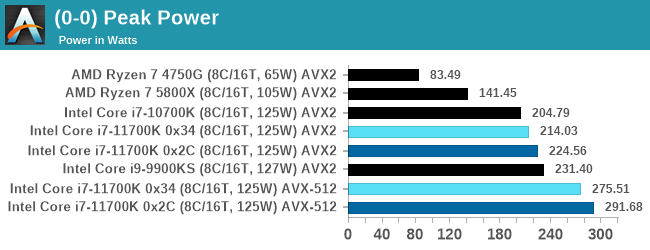



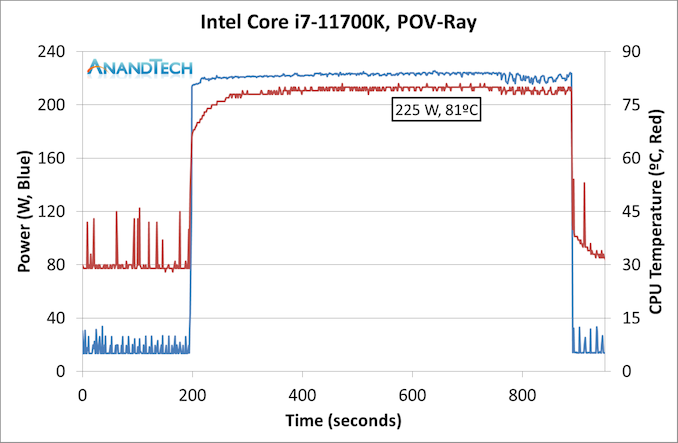
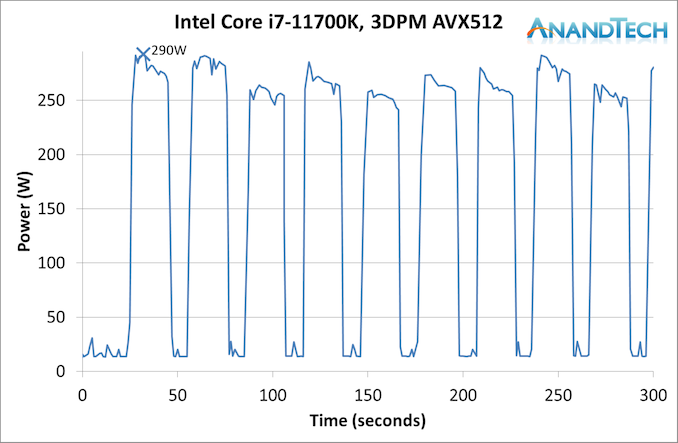
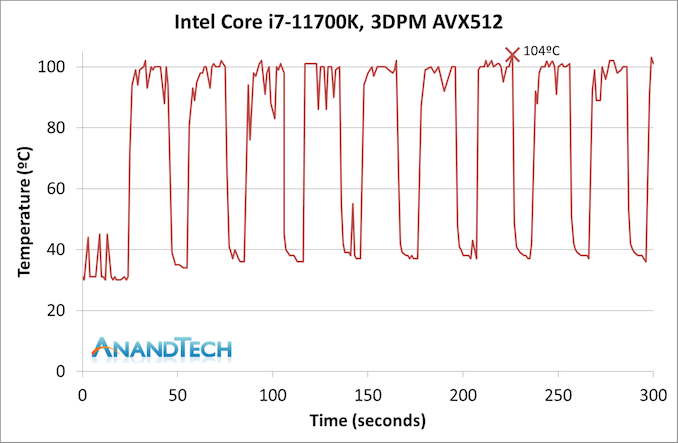


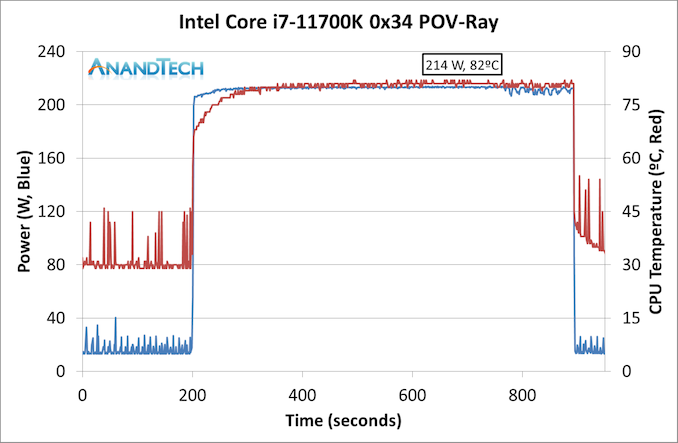








541 Comments
View All Comments
jacropolis - Sunday, March 7, 2021 - link
The 10700K is regularly $279 at Micro Center and isn't a bad buy for that price at all.Jadi - Sunday, March 7, 2021 - link
350 Dollar you want a 10700k and comparing it with a 5800X?Why?
The 5800X don t have a gpu, and the 10700ks was under 320 euros allways!
Now the 10700K not KS cost 316 euros!
Hot a 14nm Chip this is the advantage its only 60 c and a 5800X comes easy over 85 c and more.
More expansiv a 5800X cost 440 euros! A 5600X cost 350 euros, more then the 10700k!
Slower its a K CPU and can boost it up. When you OC the 5800X you have less fps.
Why you think it needs more power? Becouse the 40 sec boost? That is all and under AVX512 is it the only cpu that have it.
Games and other stuff its the same power, And 5800X dosen t stop at 105 Watt it goes like 118 watts. Thats are very close too 125 watts and more is only a limit time!
Spunjji - Monday, March 8, 2021 - link
@Jadi - that last bit of your post makes no sense. The 10700K and 11700K objectively require more power than the 5800X to do the same amount of work; the 5800X only hits 118 Watts under the same conditions that the other two approach 200 Watts. If you're comparing power draw during gaming, the 5800X uses less power than those two - roughly 25W less than the 10700K.Comparing temperatures is daft too. 85 degrees is way under the CPU's junction temperature, so it's not a problem to runa cPU at that temp - and it's objectively easier to keep an AMD CPU at that temperature than to keep an Intel chip at 60 degrees, because your cooler isn't dissipating as much heat.
TrueJessNarmo - Tuesday, March 9, 2021 - link
10700k is $320 on amazon and 9900k is $250 at microcenter.At this point 5900x is best for serious users and 9900k/10700k is for gamers. 5600x and 5800x are overpriced for what it is, but 5900x is a sweet deal at $550
rfxcasey - Wednesday, March 17, 2021 - link
I got my 10700K for 330 dollars new, I've seen them go for as low as 300.Makste - Saturday, March 6, 2021 - link
With gaming it's not the power consumption that's the problem here, it is the gaming performance in these benchmarks against comet lake obviously due to a higher latency.Zen 3's efforts have been put into perspective here, those engineers did quite a commendable job.
Bfree4me - Sunday, March 7, 2021 - link
Agreed! The Zen architecture is top shelf. But it took far too long. My last AMD Cpu was an Athlon 1800 because at that time AMD was the value leader and Intel was the performance king for a price. At the time came where I needed performance over value.So I have been Intel since then. Time to start looking towards Zen 🤔
Timoo - Monday, March 8, 2021 - link
If I may be so free: "Took way too long": I agree.I just keep in mind that it took them way too long, because Intel managed to create some very shady deals with retailers, effectively pushing AMD out of the market and to the brink of bankruptcy. So, for years AMD has been struggling to stay alive.
Agreed, buying ATi didn't help either. But without those shady deals they might have pulled it off. From 2006 to -say- 2015 AMD was only struggling to stay alive. I believe they had some huge cash injection at the time, together with getting one of the best CPU designers in the world (what's his name?) back in the house.
So, in my opinion, AMD is forgiven for their 10-year "heart-attack".
GeoffreyA - Monday, March 8, 2021 - link
I also believe it was because the K10, or Phenom, while being faster than the Athlon 64, was not aggressive enough. It had already been designed before Core 2 Duo came out, and by then, Intel was ahead of them. Who knows, they might have narrowed the gap if they had persisted with the K10 design, widening everything till it matched/surpassed Nehalem, but they shot too far, going for Bulldozer, which was supposed to turn the tables round but sank them further in the ditch.TheinsanegamerN - Monday, March 8, 2021 - link
And yet AMD was having trouble supplying enough chips to the limited market they did have. Much like today. OEMs are not going to sign up with a company that cant consistently supply CPUs.Dont forget the billiosn they poured into making GF and pissing off TSMC in the process.